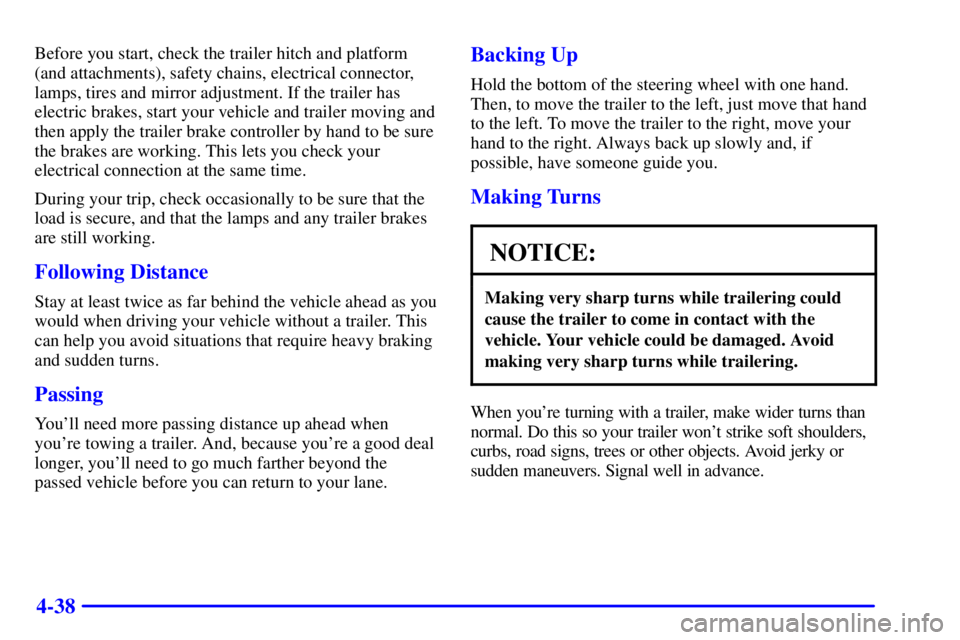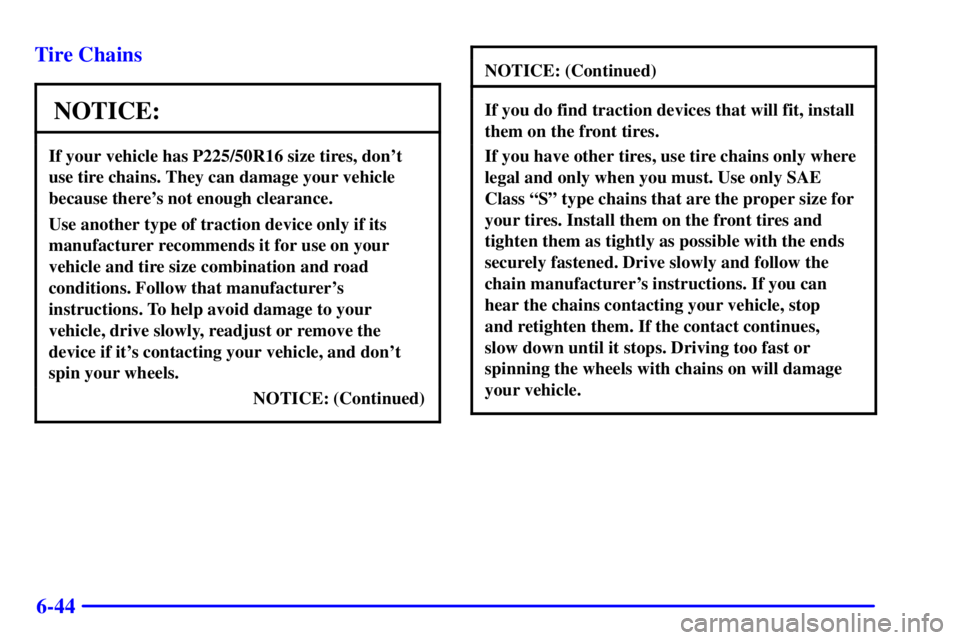Page 206 of 341
4-33
CAUTION:
Do not load your vehicle any heavier than the
GVWR, or either the maximum front or rear
GAWR. If you do, parts on your vehicle can
break, and it can change the way your vehicle
handles. These could cause you to lose control
and crash. Also, overloading can shorten the life
of your vehicle.
CAUTION:
Things you put inside your vehicle can strike
and injure people in a sudden stop or turn, or in
a crash.
�Put things in the trunk of your vehicle. In a
trunk, put them as far forward as you can.
Try to spread the weight evenly.
�Never stack heavier things, like suitcases,
inside the vehicle so that some of them are
above the tops of the seats.
�Don't leave an unsecured child restraint in
your vehicle.
�When you carry something inside the
vehicle, secure it whenever you can.
�Don't leave a seat folded down unless you
need to.
Page 211 of 341

4-38
Before you start, check the trailer hitch and platform
(and attachments), safety chains, electrical connector,
lamps, tires and mirror adjustment. If the trailer has
electric brakes, start your vehicle and trailer moving and
then apply the trailer brake controller by hand to be sure
the brakes are working. This lets you check your
electrical connection at the same time.
During your trip, check occasionally to be sure that the
load is secure, and that the lamps and any trailer brakes
are still working.
Following Distance
Stay at least twice as far behind the vehicle ahead as you
would when driving your vehicle without a trailer. This
can help you avoid situations that require heavy braking
and sudden turns.
Passing
You'll need more passing distance up ahead when
you're towing a trailer. And, because you're a good deal
longer, you'll need to go much farther beyond the
passed vehicle before you can return to your lane.
Backing Up
Hold the bottom of the steering wheel with one hand.
Then, to move the trailer to the left, just move that hand
to the left. To move the trailer to the right, move your
hand to the right. Always back up slowly and, if
possible, have someone guide you.
Making Turns
NOTICE:
Making very sharp turns while trailering could
cause the trailer to come in contact with the
vehicle. Your vehicle could be damaged. Avoid
making very sharp turns while trailering.
When you're turning with a trailer, make wider turns than
normal. Do this so your trailer won't strike soft shoulders,
curbs, road signs, trees or other objects. Avoid jerky or
sudden maneuvers. Signal well in advance.
Page 238 of 341
5-25 Storing the Flat Tire and Tools
CAUTION:
Storing a jack, a tire or other equipment in the
passenger compartment of the vehicle could
cause injury. In a sudden stop or collision, loose
equipment could strike someone. Store all these
in the proper place.
Storing the flat tire in the compact spare tire
compartment. Place the tire in the compartment, then
secure the adapter and the wing nut. Place the cover and
the nut on top of the flat tire. Store the jack and the
wrench in the foam tray.
A. Nut
B. Wing Nut
C. Adapter
D. WrenchE. Jack
F. Tool Tray
G. Flat Tire
Page 273 of 341
6-32 Headlamps
1. Lift up on the two retaining clips which secure the
headlamp assembly.
2. Lift the headlamp assembly forward, out of the
mounting bracket.
3. Turn the bulb assembly retainer counterclockwise
one
-sixth of a turn and pull out the bulb assembly.
4. Unclip the bulb assembly from the wiring harness.
5. After replacing the bulb, reverse Steps 1 through 4 to
reinstall the bulb assembly and headlamp housing.
Page 285 of 341

6-44 Tire Chains
NOTICE:
If your vehicle has P225/50R16 size tires, don't
use tire chains. They can damage your vehicle
because there's not enough clearance.
Use another type of traction device only if its
manufacturer recommends it for use on your
vehicle and tire size combination and road
conditions. Follow that manufacturer's
instructions. To help avoid damage to your
vehicle, drive slowly, readjust or remove the
device if it's contacting your vehicle, and don't
spin your wheels.
NOTICE: (Continued)
NOTICE: (Continued)
If you do find traction devices that will fit, install
them on the front tires.
If you have other tires, use tire chains only where
legal and only when you must. Use only SAE
Class ªSº type chains that are the proper size for
your tires. Install them on the front tires and
tighten them as tightly as possible with the ends
securely fastened. Drive slowly and follow the
chain manufacturer's instructions. If you can
hear the chains contacting your vehicle, stop
and retighten them. If the contact continues,
slow down until it stops. Driving too fast or
spinning the wheels with chains on will damage
your vehicle.
Page 328 of 341
8-2
Pontiac Cares
With PONTIAC CARES, you are never more than
a phone call away from having your concern taken
care of.The PONTIAC CARES philosophy and elements are
designed to make you realize that Pontiac recognizes
you as a valuable customer, appreciates your purchase
decision, and is dedicated to taking care of the most
important person ... YOU! PONTIAC CARES is: A
valuable feature that comes with every Pontiac, a feature
that offers a multitude of benefits that can give you
safety, security, comfort and convenience.
Page 334 of 341
8-8
Pontiac Roadside Assistance Program
Security While You Travel
1-800-ROADSIDE (1-800-762-3743)
As the proud owner of a new Pontiac vehicle, you are
automatically enrolled in the Pontiac Roadside Assistance program. This value
-added service is
intended to provide you with peace of mind as you
drive in the city or travel the open road.
Pontiac's Roadside Assistance toll
-free number is
staffed by a team of technically trained advisors, who
are available 24 hours a day, 365 days a year.
We take anxiety out of uncertain situations by providing
minor repair information over the phone or making
arrangements to tow your vehicle to the nearest
Pontiac dealer.
We will provide the following services for
3 years/36,000 miles (60 000 km), at no expense to you:
�Fuel delivery
�Lock
-out service (identification required)
�Tow to nearest dealership for warranty service
�Change a flat tire
�Jump starts
Page 335 of 341

8-9
We have quick, easy access to telephone numbers of the
following additional services depending on your needs:
�Hotels
�Glass replacement
�Tire repair facilities
�Rental vehicle or taxis
�Airports or train stations
�Police, fire department or hospitals
In many instances, mechanical failures are covered
under Pontiac's comprehensive warranty. However,
when other services are utilized, our advisors will
explain any payment obligations you might incur.
For prompt and efficient assistance when calling, please
provide the following information to give the advisor:
�Location of vehicle
�Telephone number of your location
�Vehicle model, year and color
�Mileage of vehicle
�Vehicle Identification Number (VIN)
�Vehicle license plate numberPontiac reserves the right to limit services or
reimbursement to an owner or driver when, in Pontiac's
judgement, the claims become excessive in frequency or
type of occurrence.
While we hope you never have the occasion to use our
service, it is added security while traveling for you and
your family. Remember, we're only a phone call away.
Pontiac Roadside Assistance
-- 1-800-ROADSIDE
or 1
-800-762-3743, text telephone (TTY) users,
call 1
-888-889-2438.
Canadian Roadside Assistance
Vehicles purchased in Canada have an extensive
Roadside Assistance program accessible from anywhere
in Canada or the United States. Please refer to the
separate brochure provided by the dealer or call
1
-800-268-6800 for emergency services.